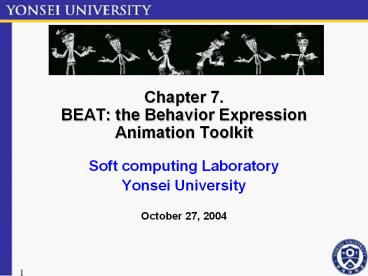Chapter 7. BEAT: the Behavior Expression Animation Toolkit - PowerPoint PPT Presentation
Title:
Chapter 7. BEAT: the Behavior Expression Animation Toolkit
Description:
Control the movement of the hands, arms and face, and the intonation of the voice ... Not only use words but also intonation, hand gestures, facial displays, eye gaze, ... – PowerPoint PPT presentation
Number of Views:331
Avg rating:3.0/5.0
Title: Chapter 7. BEAT: the Behavior Expression Animation Toolkit
1
Chapter 7.BEAT the Behavior Expression
Animation Toolkit
- Soft computing Laboratory
- Yonsei University
- October 27, 2004
2
Outline
- Introduction
- Conversational behavior
- Related work
- System
- Knowledge base
- Language tagging
- Behavior suggestion
- Behavior selection
- Behavior scheduling and animation
- Extensibility
- Example animation
- Conclusion
3
Introduction
- Association between speech and other
communicative behaviors - Poses particular challenges to procedural
character animation techniques - Voice is called for
- Issues of synchronization and appropriateness
render disfluent otherwise more than adequate
techniques - BEAT
- Allows one to animate a human-like body using
just text as input - Uses linguistic and contextual information
contained in the text - Control the movement of the hands, arms and face,
and the intonation of the voice
4
Conversational behavior
- To communicate with one another
- Not only use words but also intonation, hand
gestures, facial displays, eye gaze, head
movements and body posture - Co-occurrence of behaviors is almost equally
important - Communicative intention and the timing of all of
them are based on the most essential
communicative activity - When people tried to tell a story without words,
their gestures demonstrated entirely different
shape and meaning characteristics as compared to
when the gestures accompanied speech
5
Related work
- Until the mid-1980s or so
- Manually enter the phonetic script that would
result in lip-synhing of a facial model to speech - Today
- Automatically extract visemes from typed text in
order to synchronize lip shapes to synthesized or
recorded speech - There have been a smaller number of attempts to
synthesize human behaviors specifically in the
context of communicative acts - Synthesis of animated communicative behavior
started from - Underlying computation-heavy intention to
communicate ? computational heavy - Set of natural language instructions ? do not
guide its speech - State machine specifying whether or not the
avatar or human participant was speaking
6
BEAT
System
- Goal
- Input is a typed script
- Output is automatically produced appropriate
nonverbal behavior synchronized with speech - Approach
- Analyze the text for certain linguistic features
- Generate nonverbal behavior based on those
features, knowledge bases and research into human
conversational behavior - Compile the behaviors and schedule them to be
animated in synchrony with speech
7
BEAT system architecture
System
8
XML trees passed among modules
System
9
Knowledge base
System
- Knowledge base
- Adds some basic knowledge about the world to what
we can understand from the text itself - Allows us
- draw inferences from the typed text
- Specify the kinds of gestures that should
illustrate it and the kinds of places where
emphasis should be created - Common gestures include
- Beat, deictic and contrast gesture
- Gestures are added to the database by the
animator
10
Language tagging
System
- Language module
- Responsible for annotating input text with the
linguistic and contextual information - Allows successful nonverbal behavior assignment
and scheduling - Automatically recognizes and tags units in the
text typed by the user - Language tags
- Clause
- Theme and rheme
- Word newness
- Contrast
- Objects and actions
11
Behavior suggestion
System
- Behavior suggestion module
- Operates on the XML trees produced by the
Language Tagging module - Behavior suggestions are specified with
- Tree node, priority, required animation
degrees-of-freedom, and any specific information
needed to render them - Current set of behavior generators implemented in
the toolkit - Beat gesture generator
- Surprising feature iconic gesture generator
- Action iconic gesture generator
- Contrast gesture generator
- Eyebrow flash generator
- Gaze generator
- Intonation generator
12
Behavior selection
System
- Behavior selection module
- Analyzes the tree that contains many, potentially
incompatible, gesture suggestions - Reduces these suggestions down to the set that
will actually be used in the animation - Conflict resolution filter
- Detects all nonverbal behavior suggestion
conflicts - Resolves the conflicts by deleting the
suggestions with lower priorities - Priority threshold filter
- Removes all behavior suggestions whose priority
falls below a user-specified threshold
13
Behavior scheduling and animation
System
- Two ways to achieve synchronization between
character animation subsystem and a subsystem for
producing the characters speech - To obtain estimates of word and phoneme timings
and construct an animation schedule prior to
execution - To assume the availability of real-time events
from a TTS engine and compile a set of
event-triggered rules to govern the generation of
the nonverbal behavior
14
Extensibility
System
- Collaborating with Alias/Wavefront to integrate
- BEAT with Maya
- Designed to be extensible in several significant
ways - New entries can easily be made in the knowledge
base to add new hand gestures to correspond to
domain object features and actions - The range of nonverbal behaviors and the
strategies for generating them can easily be
modified by defining new behavior suggestion
generators - Entire modules can be easily re-implemented
simply by adhering to the XML interfaces
15
First example
Example Animation
- You just have to type in some text, and the
actor is able to talk and gesture by itself
16
Second example
Example Animation
- I dont know if this is a good thing or a bad
thing
17
Conclusion
- BEAT
- Flexible platform for procedural character
animation of nonverbal conversational behaviors
synchronized with speech - It's Not What You Say, But How You Say It
- Future work
- More complete coverage of conversational behavior
- Extending to multiple characters
- Extending to additional animation systems
- Speed































